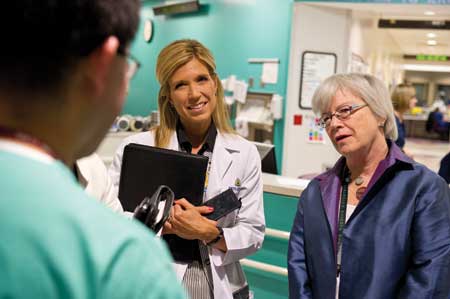Nurses Play Key Role in Multidisciplinary Rounds
by Sara Michael
When The Johns Hopkins Hospital’s Weinberg Intensive Care Unit opened in 2000, a survey given to members of the care team after daily rounds revealed a problem: not everyone was clear on the plan of care.
The nursing leadership decided to prevent these misunderstandings by adding more structure to the rounds. They instituted a daily goal sheet, which is filled out and reiterated—it’s one way the WICU has worked to ensure that each member of the diverse, multidisciplinary care team is on the same page.
“It really brought us to a place where everyone understands what is going on,” says WICU nurse manager Donna Prow, BSN, RN.

While other floors have adopted a similar approach, each unit at The Johns Hopkins Hospital tackles daily rounds in its unique way, depending on the unit culture. Across the hospital, the multi-disciplinary approach to daily rounds may differ by unit—some are nurse-led, some include families—but the goals are the same: enhance communication among disciplines and ultimately improve patient care.
“It takes so many different people to take care of a patient,” says Karen Davis, PhD, RN, director of nursing for the Department of Medicine.
Recognizing the need to bring together the different disciplines, The Johns Hopkins Hospital leadership have instituted their own form of interdepartmental rounds. The quarterly rounds, which started in August, include Karen Haller, PhD, RB, vice president for nursing and patient care services; School of Nursing Dean Martha Hill, PhD, RN, FAAN; Redonda Miller, MD, MBA, vice president for medical affairs; and Paul Rothman, MD, CEO of Johns Hopkins Medicine and dean of the School of Medicine.
These rounds allow hospital leadership to visit a few units, talk with staff, and communicate with each other about achievements and needs. Unit staff have a chance to share their stories and concerns. When the group visited Prow’s unit recently, for example, she was able to explain a growing staffing trend there: nurses leaving to attend school to become certified registered nurse anesthetists. For Davis’s units, she had a chance to show how the older facilities might be affecting patient satisfaction.
When leaders from Nursing and Medicine conduct rounds, it sets the example for how we want to work together,” says Rothman. “Our idea is that teamwork is essential for the success of The Johns Hopkins Hospital.”
Indeed, that teamwork is at the heart of the multidisciplinary rounds taking place daily on the unit level. In some units, including the WICU, which follows a family-centered care model, patients and families are part of the care team, alongside the nurses, residents, intensivists, pharmacists, therapists, and others. Having families present helps avoid any mis-understanding in the plan of care and builds family trust of the team, says Prow.
 The Pediatrics Department has included families on daily rounds since 2007, allowing them to provide input and ask questions. The parents leave with a better understanding of the plan and the goals for hospitalization, which can mean less frustration and fewer questions at the end of the day, says Tricia Willis, BSN, RN, NCIII. “The family is considered part of the medical team,” she explains.
The Pediatrics Department has included families on daily rounds since 2007, allowing them to provide input and ask questions. The parents leave with a better understanding of the plan and the goals for hospitalization, which can mean less frustration and fewer questions at the end of the day, says Tricia Willis, BSN, RN, NCIII. “The family is considered part of the medical team,” she explains.
Pediatrics and WICU are also among the units that involve the bedside nurse in rounds. In July, the Department of Medicine changed its approach to include nurses. In the past, the bedside nurse was busy taking care of patients during rounds, Davis says, but involving them has become a critical component for care coordination. Rounds there take place at 8:45 a.m., and the multidisciplinary team—nursing, social work, physical therapy, pharmacy, and patient navigator, to name a few—focuses on removing barriers to discharge. The process is concise and organized.
“It’s a chance for everyone to contribute their piece of the patient care picture, so we are uncovering all the potential problems,” she says.
In the Neuroscience Critical Care Unit, rounds are nurse-led, meaning the nurse presents the patient to the team. This process evolved because historically the nurse would do the initial neurological exam on a patient, often before the physicians went to the rooms. Neuro patients can change quickly or present differently, depending on when an exam takes place, explains Gail Biba, BSN, RN, nurse manager for the unit.
“We get to talk about the details of the neuro exam and what we observed together, so there is no miscommunication about the patient’s condition,” she says.
This unit also uses a fill-in-the-blanks paper report that provides clinical context and helps cut out inconsistencies, Biba says. “That’s an essential element” to the daily rounds, she adds.
Leading rounds isn’t quite second nature for all nurses. Knowing what information to present can be challenging, and it can be an intimidating gig. In the Neuroscience Critical Care Unit, training for leading rounds starts during orientation, where nurses work with their preceptor before taking on the responsibility, Biba says. They then quickly gain confidence and accountability as their colleagues see the nurses’ critical leadership role.
The multidisciplinary rounds can also help build and maintain strong relationships in the unit across the disciplines, Biba says. “It’s one team. Everyone discusses the patients and establishes a plan of care together.”